Modern search engine optimisation requires knowledge about how search engine results pages (SERPs) evolved from basic text links into sophisticated multi-format information centres.
Having worked in SEO for 6 years, I’ve seen the bulk of these changes and have consistently experimented, optimising for each new feature.
When a new SERP feature landed in the early days, I panicked, thinking that the roof was caving in and the doomsday of all things e-commerce was nigh. Now, a little longer in the tooth, I see new features as less of a threat and more of an opportunity.
In this article, I’ll explain the types of technologies each part of the SERP uses to draw its results and offer some tips and tricks for bagging your spot outside of traditional results.
Contents:
- Optimising for each stage of the SERP evolution
- 1. Ten blue links – traditional results
- 2. Featured Snippets & People Also Ask boxes
- 3. Carousels & Packs
- 4. Rich Media Listicles
- 5. AI Overviews
- How can brands simplify their strategy to focus on the important things?
- The playbook for SMEs
- The playbook for enterprise brands
- Measurement & Attribution for The Current State of Search
- Summary: Modern SERP Optimisation
Optimising for each stage of the SERP evolution:
It’s crucial not to get distracted by new fancy SERP features and end up ignoring the substantial traffic and brand awareness available across the entirety of Google’s search landscape. Look at each SERP feature as a new addition, not the whole story. Here, we’ll give a timeline of these SERP features and provide advice on how you can rank within each.
And to show we know what we’re talking about, each example will be preceded by an image of one of our clients ranking in said feature.
1: Ten Blue Links
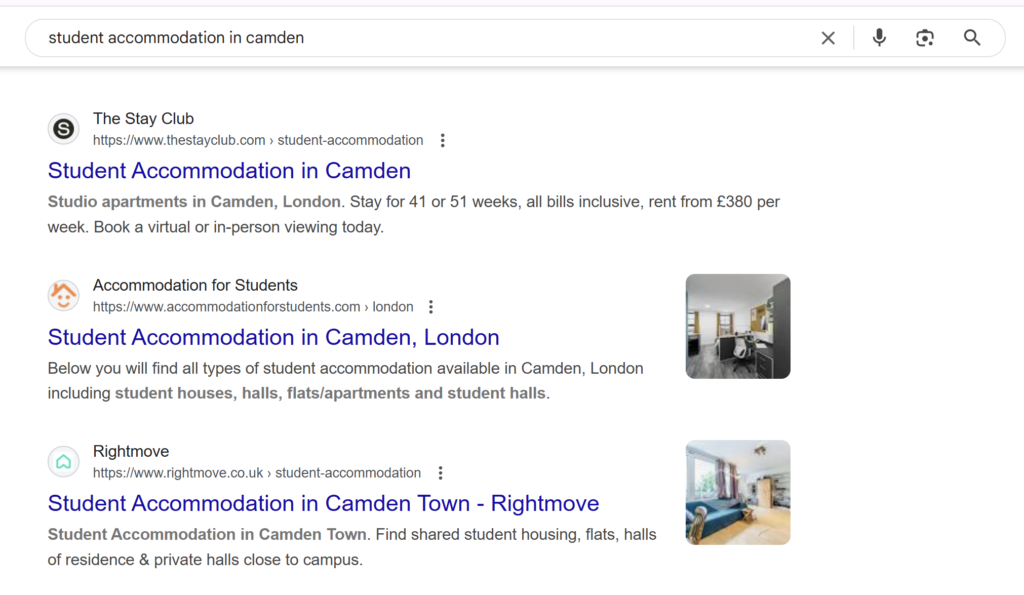
These are still a mainstay of Google’s landscape; text links with meta descriptions and image thumbnails. Rankings originally hinged on keyword density and backlinks. With new ways of reading content and websites, and new ways of understanding the best result for the search, sites earn their place here via a whole stack of SEO approaches. We’ll touch on that in a second, but first, let’s please recognise that these results are still incredibly valuable, with CTRs going all the way up to 50% (based on our client data sets).
Here’s how to optimise for traditional Google results:
- Maintain your emphasis on developing thorough content that responds to user inquiries.
- Focus on technical SEO requirements: indexation, page speed, mobile-friendly design, etc.
- Build quality backlinks from relevant sources.
- Use schema markup to enhance your listings.
- Target keywords which are predominantly a classic listing.
2: Featured Snippets & PAA
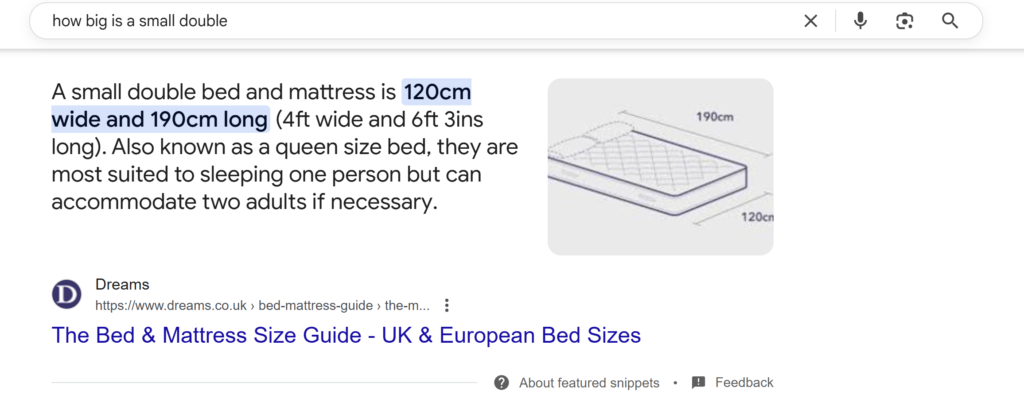
In 2014, Google launched answer boxes above organic results—position 0. SEOs panicked then learned to write explicit Q&A content to win that slot. A little further in Google’s evolution, this question answer format was developed into a “People Also Ask” (PAA) section.
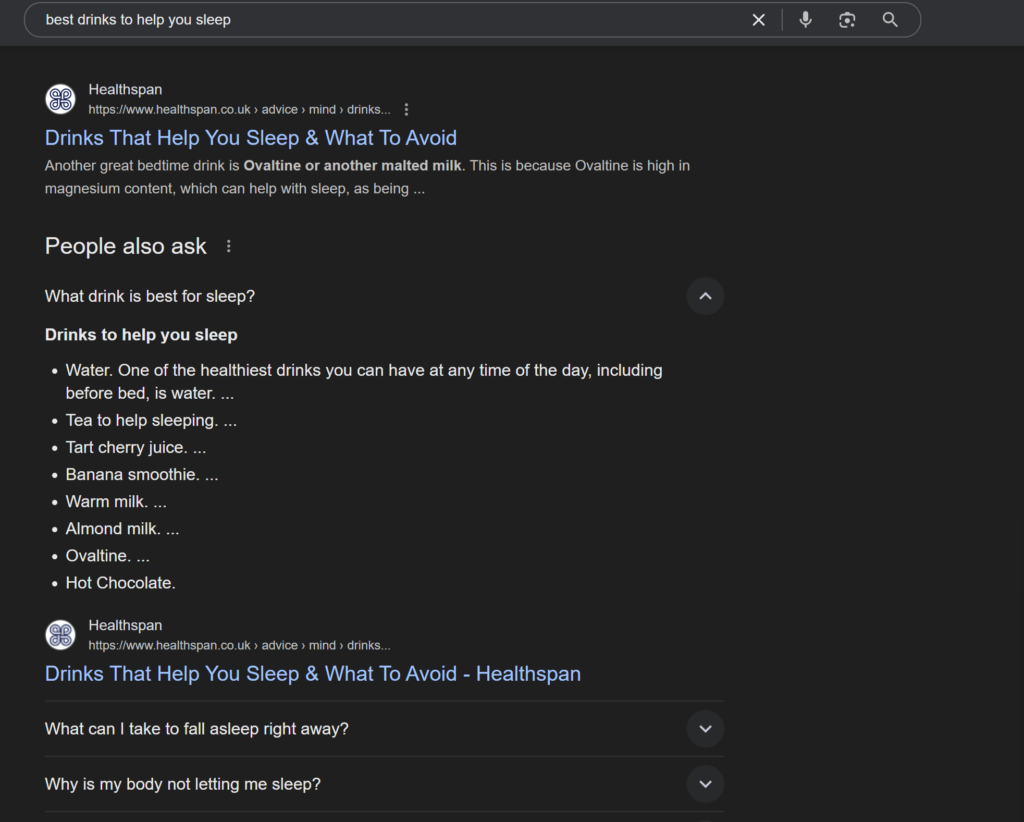
Given the placement of snippets, and the prominence of PAAs, often breaking up the top 3 positions, it’s important to bag presence here. Here’s how:
- Organise your content through question-and-answer structures
- Use HTML formatting for questions
- Provide concise, accurate answers
- Create FAQ sections addressing common related queries
- Organise content through hierarchical structures which demonstrate topic connections between different elements.
- Use schema markup specifically for FAQ content.
- Link between related content pieces to establish topical authority.
3: Carousels & Packs
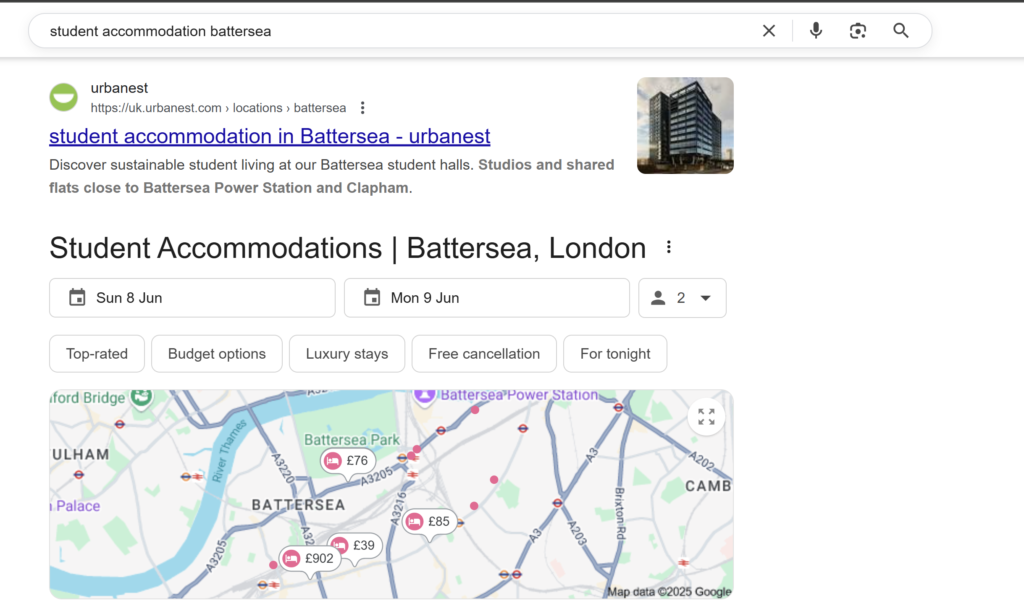
Map packs, video, images, and shopping carousels now appear much more prominently than ever before. Search has become a multimedia grid, not just links. Another prominent search feature, particularly for those searches which are informational but very close to a transaction, think “best x for y” type queries. Techniques vary for earning a spot in these features, but here’s some best practice:
- Implement schema markup thoroughly – organisation, product, local business etc.
- Include comprehensive product specifications
- Secure and present high-quality reviews
- Maintain consistent pricing and service information
- Optimise images with descriptive filenames and proper alt text.
4: Rich Media Listicles
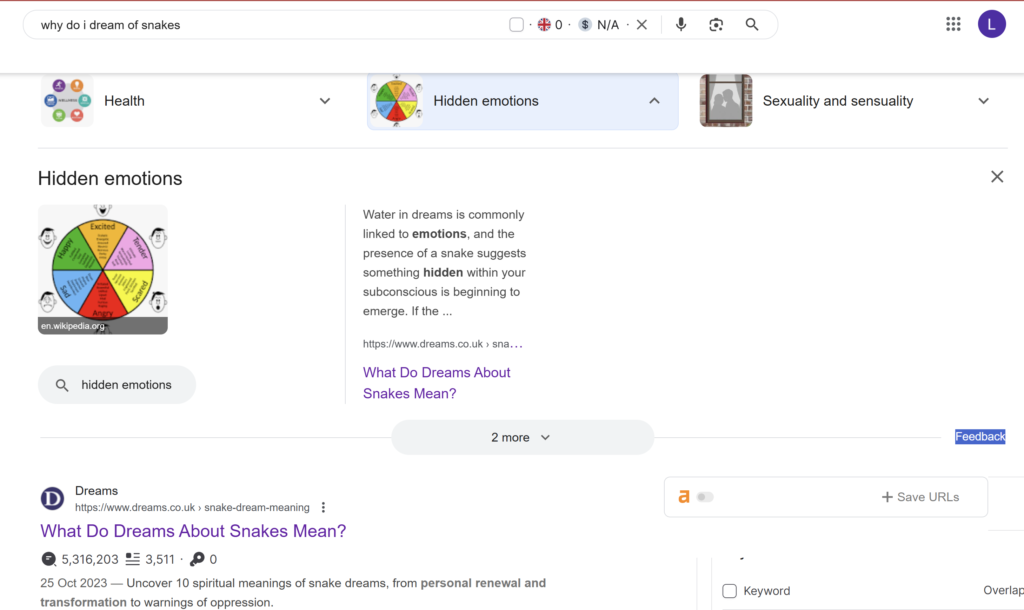
Advances in NLP let Google spot “list” content and surface listicles with images, video thumbnails and interactive widgets. As above, these results create a simple listicle on the SERP and link to individual sites within each dropdown.
Here’s how you can earn your spot:
- Produce lists which include specific numbers together with detailed subheadings.
- Each list item should contain high-quality images that receive proper alt text description.
- Use structured data markup for lists
- Keep list items concise but informative
- Ensure list content has mobile-friendly formatting.
5: AI Overviews
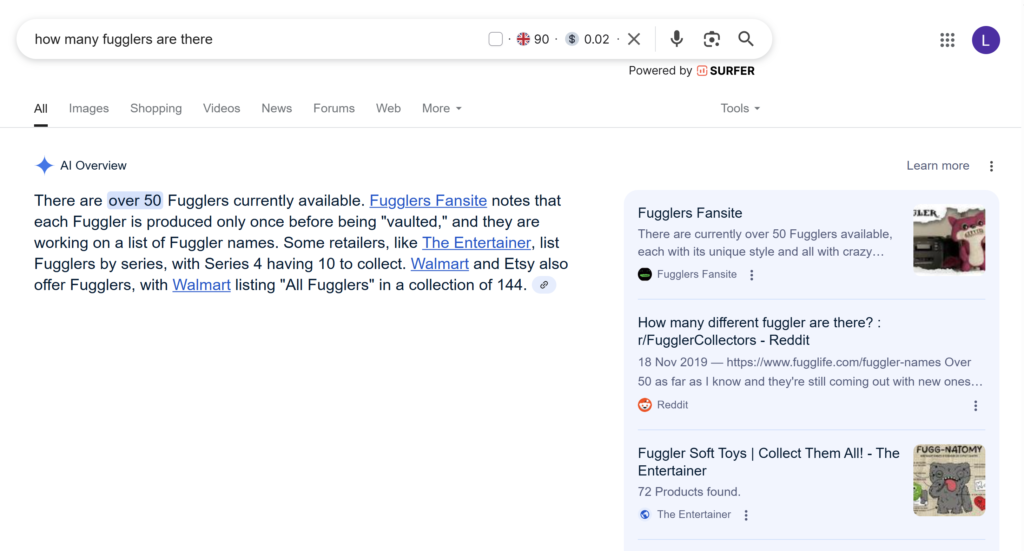
Generative AI overviews now sit atop SERPs. Despite the noise, they’re merely one part of the SERP. However, they are worth targeting. Particularly given recent analysis from Google showing an increase in clicks to linked websites. Over the coming weeks, we’ll explore how you can earn greater visibility in AIOs via more articles and a webinar. Follow Jimmy and Liam on LinkedIn to stay in the loop. For now, here’s the basics:
- Demonstrate an understanding of E-E-A-T criteria.
- Cite credible sources and provide factual information.
- Structure content to be easily parsed by AI systems.
- Use clear headings and subheadings that match search intent
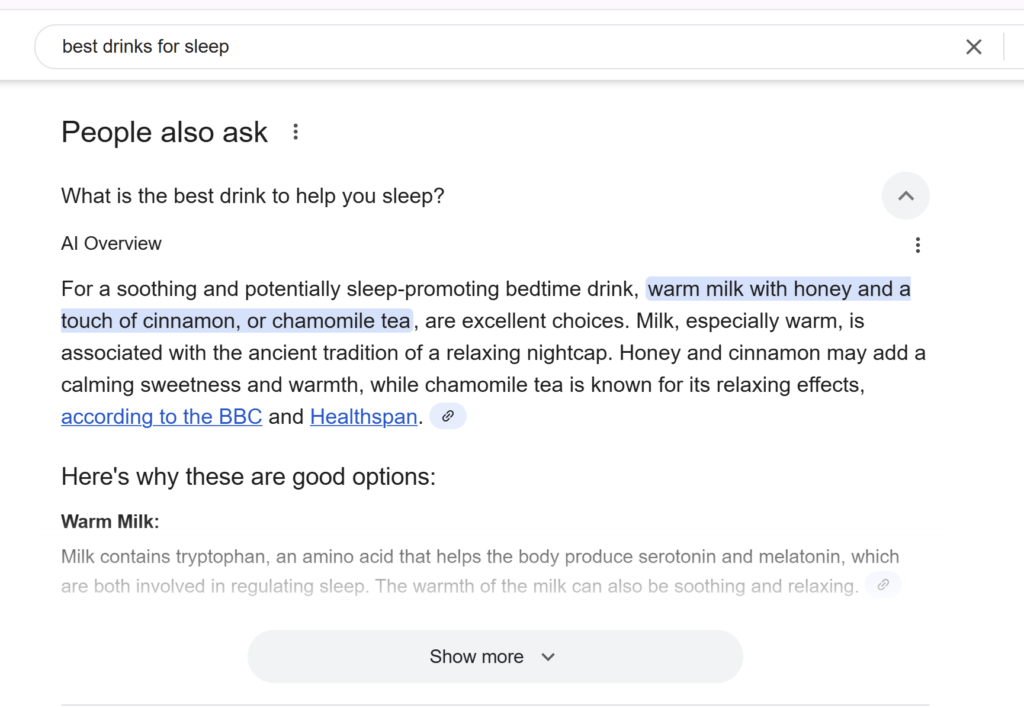
As above, and somewhat annoyingly, AIOs now also appear in PAA dropdowns. So, it’s even more important to optimise with AIOS in mind, given they appear in other SERP features!
How are AI Overviews impacting search?
The noise around the prominence of AIOs and their impact on website traffic is pretty all-encompassing. Here are some headline stats from authority sources:
- AI Overviews appeared in 13.14 % of US desktop searches in March 2025 (up from 6.49 % in January). Source: Search Engine Land.
- In the UK, AIO prevalence hit 18% in early 2025. Source: seoforgooglenews.com.
- When an AIO appears, top pages lose around 34.5% of click-through rate on average. Source: seoforgooglenews.com.
- Mobile users see AIOs occupy up to 48% of their screen, pushing organic listings out of view. Source: Search Engine Journal.
To add our own voice to the mix, we’ve analysed a set of 100,000 queries from the content hubs of our client Dreams. The analysis explored articles which have presence in AI Overviews vs those which don’t. This table gives a little insight.
| Type |
Avg word count of queries |
Referring domains |
CTR change |
| Top 15 w AIOs |
5.7 |
15 |
-3% |
|
All w AIOs |
5.1 | 16 |
-2.8% |
| Top 15 w/out AIOs |
4.49 |
8 |
-1.1% |
| All w/out AIOs |
4.5 |
5 |
-2.1% |
This helped us identify that:
– Articles which specifically target long-tail questions are more likely to earn spots in AI Overviews
– Referring domains are a strong factor for bagging presence in AI Overviews
– Only 25% (0.7 of 2.8) the CTR drop seen on informational keywords are accounted for by the introduction of AI Overviews.
That last one’s a big one; put simply, those stating that AI Overviews are the biggest or only factor for CTR drops are turning a blind eye to 75% of the other factors influencing drops in traffic.
We’ll be talking through that data in detail in an upcoming webinar. Follow us on LinkedIn to stay in the loop.
How can brands simplify their strategy to focus on the important things?
In short, yes. We’ve boiled down what we’d recommend for brand willing to sail into the new world of search marketing. For SMEs we suggest concentrating on opportunities and critical search infrastructure. For enterprise brands, automation and scalable strategy is key. Here’s a breakdown.
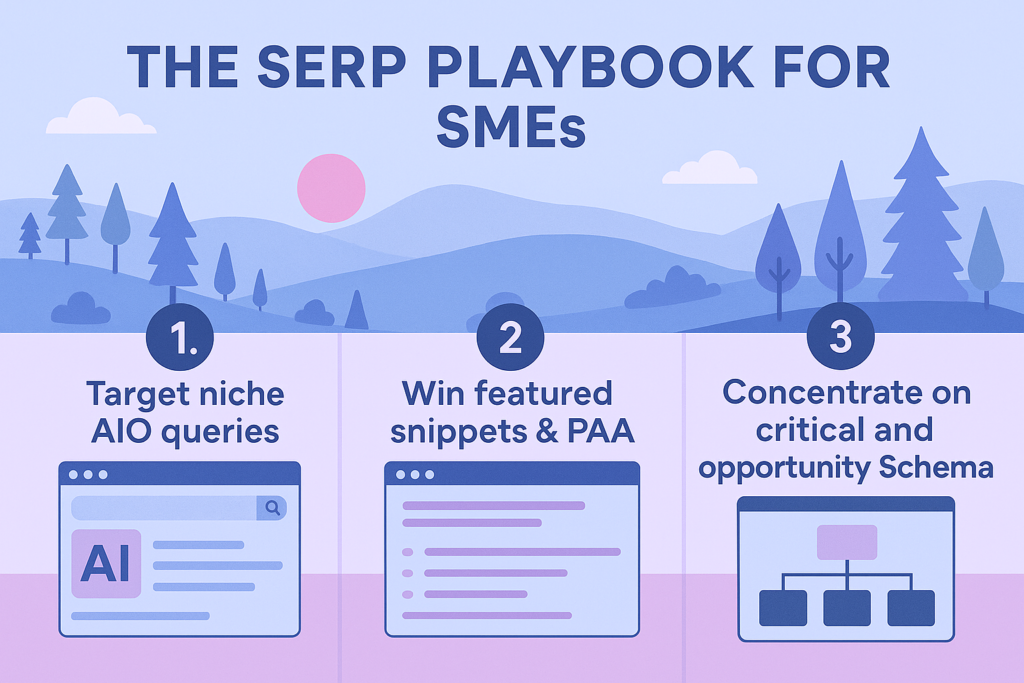
The SERP Playbook for SMEs
1. Target niche AIO queries
- Select specific long-tail questions which have minimal competition levels.
- Produce brief yet comprehensive answers that the AI technology prefers.
2. Win featured snippets & PAA.
- Make your content easier to read by using H2 and H3 tags for Q&A organisation.
- The maximum clarity for answers should be kept between 40–60 words.
3. Concentrate on critical and opportunity Schema
- Add FAQ and Q&A markup on key pages.
- Use on page signals to ensure Google can directly parse questions and answers from your web pages.
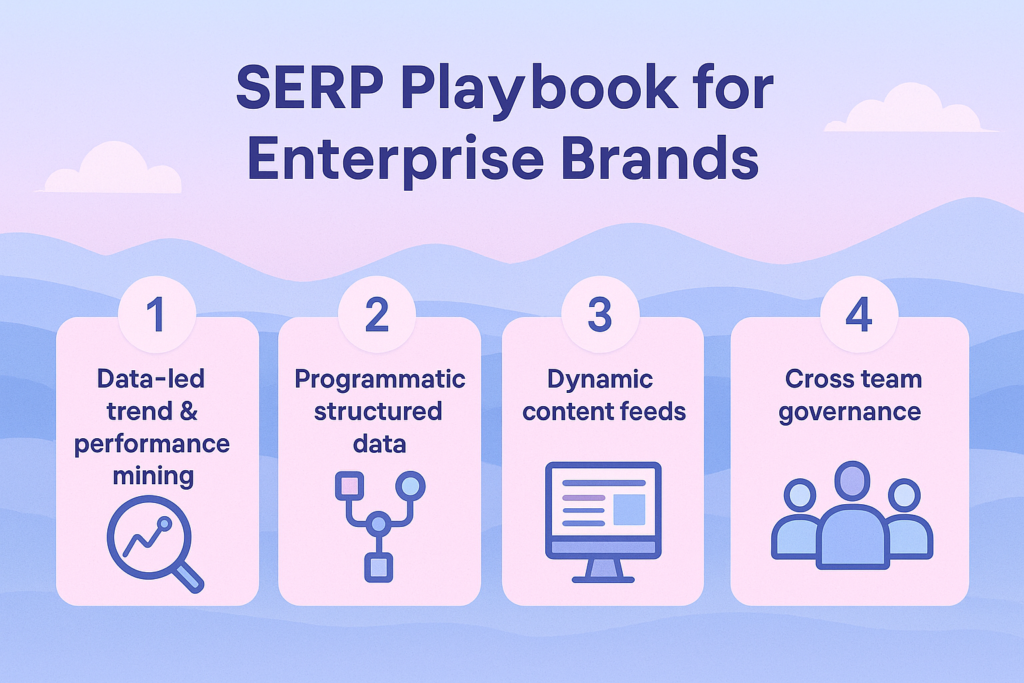
The SERP Playbook for Enterprise Brands
1. Data-driven trend mining
- You should extract your web search data from the search console through BigQuery or a BI tool.
- You should create dashboards to identify the emergence of “snippet” and AIO queries that appear by category or region.
- Prioritise gaps where impressions climb but you lack featured positions.
2. Programmatic structured data
- Your CMS should include pre-designed templates for FAQ, HowTo, Product and Event schemas.
- Your development team should create a tagging system that adds large-scale JSON-LD data.
- Your deployment pipeline should include automatic QA checks for Linting and schema validation.
3. Dynamic content feeds
- A headless CMS or data layer should integrate with live APIs (inventory, pricing, event schedules) for functionality.
- Your JSON-LD data should remain current for serving shopping, event and local pack features.
- The system should cache data intelligently to prevent server overload while maintaining fresh data availability for Google.
4. Cross-team governance & monitoring
- An SEO centre of excellence should unite SEOs, devs and data analysts under a single taxonomy framework.
- Your team should perform weekly checks to examine structured data health and AIO visibility trends.
- The insights should be directed to product, marketing and UX teams to guide them in developing content that targets new SERP layers.
Implementing these steps converts enterprise power into steady SERP victories through controlled methods instead of panic-based reactions.
Measurement & Attribution for The Current State of Search
- Track your SERP features presence against competitors
Ensure you are looking beyond traditional results. Create tracking systems which identify how much of each SERP feature you own. Use this to create a total owned space score so you can see the percentage of the SERP your brand owns vs what’s available. - Prioritise visibility over rank
Prioritise tracking visibility of categories and topical networks, impressions, and SERP feature exposure percentages. AIO or snippets visibility creates brand lift effects that persist even when organic positions decrease. The classic metric of “how many results in P1” is now somewhat irrelevant, given a boatload of P1s now sit three folds down the SERP. - Monitor engagement
Track CTR, time on page and scroll depth to get a true understanding of whether your content speaks to your users. Monitor the same metrics for content featured in snippets, PAA and AIO spots too. These will reveal actual impact beyond pure position.
A Summary: Why Modern SERP Optimisation Matters
AI Overviews function as a single part of the search environment. The natural anxiety they’ve created will likely prove to be less severe than initial predictions suggest. However, this SERP feature does stand out as particularly meaningful. Especially now we know it’s preceding AI mode. More on that in a future article.
Most importantly, it’s safe to say that organisations which grasp diverse SERP element optimisation strategies will benefit from the expanding complexity of search engine results pages. The ones that really benefit though will be those who recognise the fundamental technologies of NLP, link based algorithms, and entity SEO will remain absolutely key to online success.
In short, remember that modern SEO success requires:
Foundational excellence: Technical optimisation, quality content, and authoritative backlinks require constant attention for continued online growth.
Format diversity: Multiple content formats, including text, video, images, lists, and tables, help you reach different SERP features.
Markup: The implementation of schema markup should be widespread because it helps search engines properly feature your content and LLMs understand what you’re website and its pages are all about.
Entity optimisation: Establish your brand or organisation as a recognised entity by establishing clear connections to other entities within your field. This means connect with relevant audiences via digital PR and be present in the right conversations with proper content marketing.
Match search intent: Content must align exactly with what users seek in their searches. And by this, we mean think about how your using copy to talk to users, how your linking to content that removes barriers for your users, and how page layouts are designed around the needs of your users.
NLP optimisation: Structure your content seamlessly and with natural language processing systems in mind. Do this by establishing semantic connections between different topics and using the entire variety of language your users use.
Continuous adaptation: Regularly track industry-specific SERP modifications to develop new strategies which preserve established successful approaches.
The evolution of SERPs from simple text listings to multi-layered, AI-enhanced information hubs presents a challenge and creates new possibilities. Ranking has become more complex, but don’t forget that it also provides new avenues to gain visibility and clicks.
With the right strategy, your content will reach users no matter what changes search results undergo because you understand all SERP components and optimise across the full range of features.
